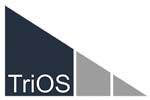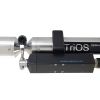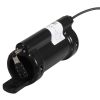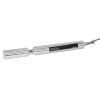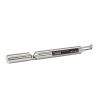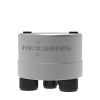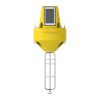TriOS OPUS UV Spectral Sensor
Features
- Internal compensation for temperature, turbidity, and organic substances
- RS-485 Modbus RTU output for integration with data collection platforms
- Optional W55 V2 wiper cleans optics & reduces maintenance intervals
- Expedited repair and warranty service
- Lifetime technical support
- More
Overview
The TriOS OPUS is a spectral sensor for the online measurement of nitrogen and carbon compounds. By analyzing a full spectrum, OPUS is able to deliver reliable readings for N-NO3, N-NO2, organic ingredients (COD, BOD, DOC, TOC) and a number of other parameters.
Mechanics
Substances with a specific absorption spectrum, such as nitrate and nitrite, can be used directly as elements of the spectral analysis group. For sum parameters, such as COD, BOD, TOC and DOC, theoretical absorption spectra that TriOS has been able to determine over the course of its many years of experience have been stored. Using these parameters, a spectral analysis based on UV absorption can use only the portion that absorbs UV light. Therefore, the OPUS uses only equivalents, and the parameters have the “eq” suffix appended to them, (i.e. CODeq, BODeq, TOCeq and DOCeq). The spectral analysis group also contains correction spectra that take into account, for example, the effects of turbidity. Because the entire absorption spectrum is detected, parameters such as SAC254 (spectral absorption coefficient at 254nm) can also be calculated.
Integration
The OPUS is compatible with the G2 interface box, allowing fast and easy configuration of the sensors using a web browser. The sensor can be easily integrated into existing process control systems and external data loggers using the native RS-485 Modbus RTU output, and the optional W55 V2 wiper reduces maintenance intervals by cleaning the optics before each measurement.
|
Light source
|
Xenon flash lamp
|
|
|
Detector
|
High-end miniature spectrometer
256 Channels
200 to 360 nm
0.8 nm/pixel
|
|
|
Measurement principle
|
Attenuation, spectral analysis
|
|
|
Optical path
|
0.3mm, 1mm, 2mm, 5mm, 10mm, 20mm, 50mm
|
|
|
|
||
|
Parameter
|
Nitrate NO3-N, Nitrite NO2-N, CODeq, BODeq, DOCeq, TOCeq,
TSSeq, KHP, SAC254, COD-SACeq, BOD-SACeq
|
|
|
Measurement accuracy
|
See measurement ranges below
|
|
|
Turbidity compensation
|
Yes
|
|
|
Data logger
|
~ 2 GB
|
|
|
T100 response time
|
2 min
|
|
|
Measurement interval
|
≥ 1 min
|
|
|
|
||
|
Housing material
|
Stainless steel (1.4571/1.4404) or titanium (3.7035)
|
|
|
Dimensions (L x Ø)
|
470 mm x 48 mm (bei 10 mm path)
|
~ 18.5“ x 1.9“ (with 10 mm path)
|
|
Weight stainless steel
|
~ 3 kg (bei 10 mm path)
|
~ 6.6 lbs (with 10 mm path)
|
|
Weight titanium
|
~ 2 kg (bei 10 mm path)
|
~ 4.4 lbs (with 10 mm path)
|
|
|
||
|
Interface digital
|
Ethernet (TCP/IP), RS-232 or RS-485 (Modbus RTU)
|
|
|
Power consumption
|
≤ 8 W
|
|
|
Power supply
|
12...24 VDC (± 10 %)
|
|
|
|
|
|
|
Maintenance effort
|
≤ 0.5 h/month (typical)
|
|
|
Calibration/maintenance interval
|
24 months
|
|
|
System compatibility
|
Modbus RTU
|
|
|
Warranty
|
1 year (EU: 2 years)
|
US: 2 years
|
|
|
||
|
Max. pressure with SubConn
|
30 bar
|
~ 435 psig
|
|
Max. pressure with fixed cable
|
3 bar
|
~ 43.5 psig
|
|
Max. pressure in FlowCell
|
1 bar, 2...4 L/min
|
~ 14.5 psig at 0.5 to 1.0 gpm
|
|
Protection type
|
IP68
|
NEMA 6P
|
|
|
||
|
Sample temperature
|
+2...+40 °C
|
~ +36 °F to +104 °F
|
|
Ambient temperature
|
+2...+40 °C
|
~ +36 °F to +104 °F
|
|
Storage temperature
|
-20...+80 °C
|
~ -4 °F to +176 °F
|
|
Inflow velocity
|
0,1...10 m/s
|
~ 0.33 fps to 33 fps
|
|
Parameter
|
Measurement Principle
|
Unit
|
Factor
|
Path Length (mm)
|
|||||||
|
|
|
|
|
0.3
|
1
|
2
|
5
|
10
|
20
|
50
|
|
|
absorbance
|
spectral
|
AU**
|
-
|
0.01...2.2
|
0.01...2.2
|
0.01...2.2
|
0.01...2.2
|
0.01...2.2
|
0.01...2.2
|
0.01...2.2
|
|
|
absorbance
|
spectral
|
1/m
|
-
|
50...7300
|
15...2200
|
7.5...1100
|
3...440
|
1.5...220
|
0.75...110
|
0.3...44
|
|
|
Nitrate N-NO3
|
spectral
|
mg/L
|
-
|
1.0...330
|
0.3...100
|
0.15...50
|
0.06...20
|
0.03...10
|
0.015...5
|
0,006...2
|
|
|
Nitrate NO3
|
spectral
|
mg/L
|
-
|
4.43...1460
|
1.33...440
|
0.67...220
|
0.27...88
|
0.13...44
|
0.067...22
|
0.030...9
|
|
|
Nitrite N-NO2
|
spectral
|
mg/L
|
-
|
1.7...500
|
0.5...150
|
0.25...75
|
0.1...30
|
0.05...15
|
0.025...7.5
|
0.01...3
|
|
|
Nitrite NO2
|
spectral
|
mg/L
|
-
|
5.6...1650
|
1.65...500
|
0.82...250
|
0.33...100
|
0.17...50
|
0.083...25
|
0.033...10
|
|
|
DOCeq
|
spectral
|
mg/L
|
-
|
17...3300
|
5.0...1000
|
2.5...500
|
1.0...200
|
0.5...100
|
0.25...50
|
0.1...20
|
|
|
TOCeq
|
spectral
|
mg/L
|
-
|
17...3300
|
5.0...1000
|
2.5...500
|
1.0...200
|
0.5...100
|
0.25...50
|
0.1...20
|
|
|
CODeq
|
spectral
|
mg/L
|
-
|
100...7300***
|
30...2200***
|
15...1100***
|
6.0...440***
|
3.0...220***
|
1.5...110***
|
0.6...44***
|
|
|
BODeq
|
spectral
|
mg/L
|
-
|
100...7300***
|
30...2200***
|
15...1100***
|
6.0...440***
|
3.0...220***
|
1.5...110***
|
0.6...44***
|
|
|
KHP
|
spectral
|
mg/L
|
-
|
17...13300
|
5.0...4000
|
2.5...2000
|
1.0...800
|
0.5...400
|
0.25...200
|
0.1...80
|
|
|
SAC254
|
Single wavelength
|
1/m
|
-
|
50...7300
|
15...2200
|
7.5...1100
|
3.0...440
|
1.5...220
|
0.75...110
|
0.3...44
|
|
|
COD-SACeq****
|
Single wavelength
|
mg/L
|
1.46
|
75...10600
|
22...3200
|
11...1600
|
4.4...640
|
2.2...320
|
1.1...160
|
0.44...64
|
|
|
BOD-SACeq*****
|
Single wavelength
|
mg/L
|
0.48
|
24...3500
|
7.2...1050
|
3.6...525
|
1.44...210
|
0.72...105
|
0.36...52.5
|
0.15...21
|
|
|
TSSeq*****
|
Single wavelength
|
mg/L
|
2.6
|
130...4300
|
40...1300
|
20...650
|
8.0...260
|
4...130
|
2.0...65
|
0.8...26
|
|
|
under laboratory conditions
** absorbance unit
*** depending on the composition of the COD and BOD (sum parameter)
**** based on KHP (Note: 100 mg/L COD-standard-solution corresponds to 85 mg/L KHP)
***** based on SiO2
Note:
1 mg/L N-NO3 corresponds to 4.43 mg/L NO3
1 mg/L N-NO2 corresponds to 3.28 mg/L NO2
|
|||||||||||
- (1) OPUS UV Spectral Sensor
- (1) Fitting for compressed air cleaning
- (1) Calibration certificate
- (1) Operations manual
- Note: Included parameters are temperature, SAC254, and TSS. Addtional parameters must be ordered separately as calibrations (see Accessories tab).
In The News
Source Water Monitoring in Albany, New York: Tracing Water Quality throughout Tributaries
Thousands of US cities pull their drinking water from natural source waters like reservoirs, rivers, and streams, making overall watershed health a key consideration for water providers. In Albany, New York, the Albany Department of Water and Water Supply delivers drinking water to over 100,000 residents as well as monitors and manages the larger drinking water supply watershed. Hannah Doherty, Environmental Specialist at the Albany Department of Water and Water Supply , spends her days working with a small team to monitor the drinking supply and the connected water bodies. Doherty explains, “We’re the first to encounter the water that ends up being the drinking water.
Read MoreWildfire Prevention in the Sierra Nevada Region with the Yuba Watershed Institute
Though recent wildfires have sparked new conversations about wildfire management and response, groups like the Yuba Watershed Institute have been monitoring the forests and water resources of the Sierra Nevada region for decades, managing approximately 5,000 acres of land with the Bureau of Land Management (BLM) and about 7,000 acres in private land partnerships. The goal of the Institute is to work with local communities and land agencies to improve watershed and forestry management through informed practices and public outreach. The goals of the Yuba Watershed Institute are three-fold: Improve the ability of fire suppression agencies like the California Department of Forestry and Fire Protection ( CAL FIRE ) and the US Forest Service.
Read MoreWave Sensors Integration with NexSens Buoys: A Cutting-Edge Solution for Wave Measurment
Real-time wave data supports accurate weather prediction, safe and efficient maritime operations, and provides valuable safety and operating condition information for recreation and commercial fishing. Understanding wave dynamics also helps with the design of protective coastal structures like seawalls, breakwaters, and jetties. It also supports better prediction of their impact on sediment transport and coastal geomorphology. Wave data is a key factor in qualifying and designing offshore wind farms and harnessing kinetic energy for electrical generation. It helps with the understanding of ocean-atmosphere interactions and contributes to studies of sea-level rise and climate change impacts.
Read More







